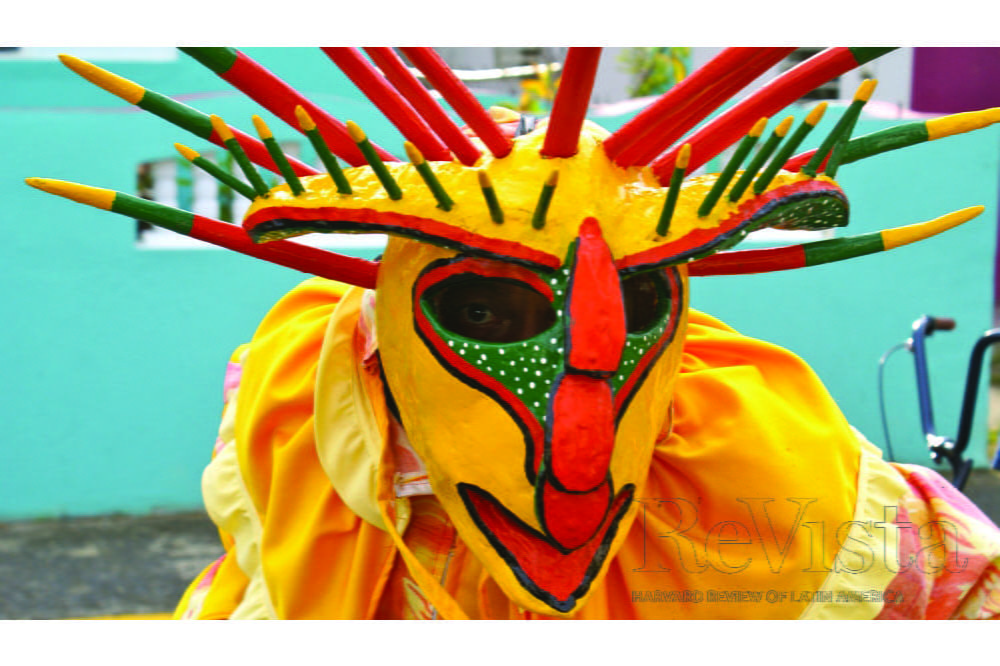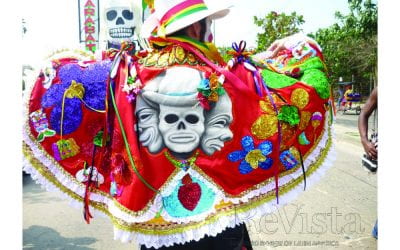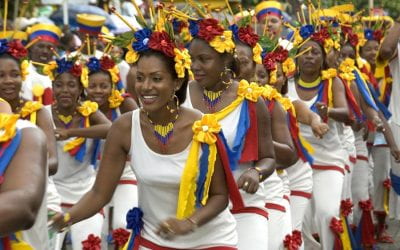Masked Enigmas
The Vejigante of the Fiestas of Santiago Apóstol in Loíza, Puerto Rico

The Vejigante remains the most iconic and dynamic of the characters in Puerto Rican celebrations, deriving from the African traditions of masquerade. Photo by Lowell Fiet.
The brilliantly colored and captivatingly grotesque mask of the Vejigante remains enigmatic. The name derives from the Spanish vejiga or bladder. Cervantes in Don Quixote describes costumed mummers—“bojiganga”—who use inflated “vejigas” on sticks as weapons to mock and chastise onlookers. The word bejigante entered the Puerto Rican lexicon by 1747. But neither reference specifically addresses the masked and horned character central to the African-Puerto Rican celebration and ritual. It is as much trickster-devil (or diablito) as sacred presence, as much dumb-show clown as sage, as much sensualist as shaman, as much a mythical and dynamic anthropomorphic face that scares children as a source of energy, strength and courage. With slightly different names, costumes, and masks, Vejigantes appear as devil-heroes of cultural performance throughout the Hispanic Caribbean and littoral Central and South America.
Two variations exist in Puerto Rico: the Vejigante of pre-Lenten Carnival in Ponce, on the south coast, with its paper-maché mask, and the Vejigante of the Fiestas of Santiago Apóstol (St. James) in Loíza, on the northeast coast, with its mask carved from coconut husks. The colorful billowy costumes used by both appear nearly identical, but the masks reflect different materials, modes of production, and historiographies. Studies ascribe African and European elements to both. The use of paper-maché and its molding on fixed forms (similar to European carnival and commedia dell’arte masks) facilitate the plasticity of the ornate horns, pikes, and crests of the Ponce version and suggest a stronger Spanish precedence. The carving of the features of the Loíza masks in hard but porous coconut husks suggests a heritage more linked to the carved wooden masks of West Africa. I will here concentrate on Loíza’s tradition because of that heritage, the elaborate narrative structure of the Fiestas, and the centrality of the role of the Vejigante.
Loíza’s African-Puerto Rican population base and the Fiestas of Santiago Apóstol, celebrated annually from July 25 to 28, make that locality the seat of African cultural influence in Puerto Rico. July 25 is Santiago’s saint day, often celebrated with a parade of floats and a bandstand for local music in the town plaza. However, the processions of the three effigies—Santiago of the Men (July 26), Santiago of the Women (July 27) and “Santiaguito” or Santiago of the Children (July 28)—are the raison d’être of the Fiestas. Each procession travels east from the town plaza in the afternoon, with devotees carrying the saints on their shoulders on Route 187 for nearly three miles to the neighborhood of Las Carreras.
It was there, the legend says, that fishermen found the carved wooden image of Santiago Apóstol (now Santiago of the Children) under a cork tree. They took the little saint to the town’s Spanish church, but during the night it miraculously escaped to return to the spot where it was found. The miracle was repeated on the two subsequent nights. By refusing to stay in the official church, the image became the people’s saint, and the three effigies of the saint stay in the community withmantenedores or keepers responsible for their care and upkeep.
The date usually cited for the discovery is around 1830, although the celebration of other saints could have preceded that. Saint’s day processions were common in Puerto Rico from the 16th century onward. The community of Loíza formed very early in the process of colonization, and its Church of the Holy Spirit and St. Patrick, built in 1645, is one of the oldest on the island. Landowners (and possibly slaveholders) of Irish descent presumably influenced the choice of St. Patrick as the official patron saint.
The warrior St. James is the patron saint of Spain, credited with appearing miraculously to help drive the Moors from the Iberian peninsula; in his representations a Moor’s head and dark face lie under the hooves of his horse. The saint’s appearance in Loíza in the early 19th century could thus relate to Catholic evangelism and efforts to convert and control the non-Spanish-speaking Africans who arrived in Puerto Rico from other Caribbean islands late in the 18th century or directly from Africa in the first decades of the 19th.
Regardless of whether the “miracle” served as strategic proselytizing or arose as an ingenious act of resistance by the free and/or enslaved African-Puerto Rican population, the saint’s popularity and the enthusiasm with which he was celebrated resulted in the addition of the two other plaster statuettes, each slightly larger than the original and each with a separate procession and celebration day. What began with one saint and probably one festival day of reduced labor and community interaction transformed itself, through devotional energy and over time, into three saints, three processions, and four days of worship and celebration.
Devotees carry the saints on litters, while in front of them devilish Vejigantes, fancy-dressed Spaniards or Caballeros, cross-dressed Locas with padded bosoms and buttocks and faces blackened with shoe polish, and tattered Viejos or Old Men, jump, dance and celebrate. The Carretón Alegre (“wagon of joy”), a sound system and mini-information center pulled by bicycle, pulses with recorded Caribbean music such as salsa, reggae, zouk, merengue, reguetón, calypso and soca. The municipal band plays traditional danzas from the platform of a roofed truck that follows the saint. Each procession arrives at the point where the cork tree of the founding legend once stood. A mosaic sculpture created by Loíza artist Daniel Lind-Ramos marks the location. The procession waits there until riders on horseback carry the flags of Santiago the roughly quarter mile back to route 187 and return. The saint and its retinue then begin to retrace their steps but quickly disperse in the music, dancing, food, and drink of celebration that lasts into the night.
On July 26, Santiago of the Men starts out in the church of the Holy Spirit and St. Patrick. The two other saints join him on the road, and all three reach Las Carreras. The following day, Santiago of the Women leaves just off the town plaza, salutes the other two saints near the houses of their mantenedores, but only Santiago of the Children continues with it to Las Carreras. On July 28, the road is reserved for “Santiaguito.” The effigy spends the night in the modern church built in his honor on Route 187 near the entrance to Las Carreras. In the morning devotees transport the saint to the plaza to celebrate with local children. At 3:30 or 4 p.m. the journey begins past the neighborhoods that line Route 187. The other statuettes salute but do not join the saint as it moves toward the point of its discovery.
The sacred and profane nature of the Fiestas fully reveals itself in the last procession. The medieval Christian strand of the litany of saints’ day parades and Cervantes’ baudy bojiganga intertwines with the profound religiosity and sensuous celebratory strand of African masquerade. The movement through blazing summer heat, ear-pounding rockets that announce the saint’s arrival, music old and new, a squadron of heavily armed police, dozens of bicycles, the horns and exhaust of backed-up traffic, riders on horseback, and the memory of violence that hangs over the route—all come together to create a transversal moment of freedom and communion.
In the 1950s, Puerto Rican archaeologist Ricardo Alegría explained the Fiestas in terms of Yoruban art and ritual practice. He saw in the image of Santiago Apóstol a suggestion of carved African effigies of Shangó, god of war, fire, thunder and lightning. More recent research finds the connection unlikely: virtually no evidence of Yoruban influence surfaces during the first three centuries of colonization, and shipping manifests record that most Africans reaching Puerto Rico in the first half of the 19th century were Congo-Bantú brought on Spanish ships that slipped through the British embargo of the slave trade. However, regardless of the origin of the African-Puerto Rican population of the Loíza region, two different cultural-religious forms and practices coincided, each complementing and facilitating the development of the other, and ultimately coming to share aesthetic and spiritual elements. The impassioned worship of the Spanish Catholic saint opened the door for the reinvention of African traditions of masquerade in the characters of the Vejigante, Caballero, Loca and Viejo.
The Vejigante remains the most iconic and dynamic of these characters. As the African-inspired trickster-diablo and the protagonist of African-Puerto Rican culture, it evokes the egungun quality of calling forth the ancestors and allowing them to return, if only briefly, to enjoy life and communicate through the bodies of the living. Whether one views that function as metaphorical or real, the mythical, otherworldly, and beast-like anthropomorphic mask preserves and reconstitutes the partially erased, broken, or submerged memory of an African past that reappears in the present.
The cultural performance of the Vejigante finds its parallel in the functions of the music, dancing and lyrics of Puerto Rican bomba, the African-inspired percussion of barrel-shaped drums with choreography that creates a dialogue between the rhythm of the drum and the body of the dancer. Current practice relegates bomba to the bandstand in the town’s plaza or to the yard of mask-making Ayala family, which the processions pass on their way to Las Carreras. However, stories circulate a memory in which bomba drummers waited at the base of the cork tree and greeted the returning saint and revelers with drumming that symbolically recreated an African homeland.
The density and specificities of the performance, its urgency and vitality, the high level of community participation and the uncontainable impulse to share and transform traditions create an act of cultural resistance and affirmation. Actors and spectators intermingle in the same space, and a multitude of onlookers waits for and then joins the processions as active participants. What begins in the town plaza with a handful of devotees and festive characters multiplies exponentially during the course of the action.
This takes place inside a broader global environment that tends to negate memory, manual arts and crafts, local knowledge and beliefs, and non-media events. The processions traverse Loíza, one of Puerto Rico’s poorest municipalities. The high under- and unemployment levels, drug trafficking, related gang and turf-war clashes, government and private development schemes, and violent confrontations with police scar the social fabric and undermine its natural tropical beauty. For a sad example, Carlos Ayala Calcaño, one of Loíza’s most talented festival artists, was killed in February 2011 as the “collateral damage” of a drive-by shooting on the same Route 187 where he danced every July as a brilliantly ecstaticVejigante.
The artist Castor Ayala solidified the classical mask style in the 1950s, 60s, and 70s. His son Raúl (the most prominent artist of masks and the leader of the Los Hermanos Ayala bomba group) preserves that style while also inventing elaborate new styles. Other prominent mask artists such as Pedro Laviera and Carlos Ayala Calcaño have added even greater plasticity to the coconut husk form. The focus on Vejigantes takes on particular significance because of the surge in participation of a new generation of performers that includes children, young adults, and, virtually unheard of previously, women. In the past five years a more individual and expressive aesthetic reflects the individual performer playing a greater role in the creation of his/her mask. Multiple variations emerge in the carving, painting and coloration, shape of tongues and eyes, and costume design. The new masks are more daringly seductive and sensual as the number of Vejigantes multiplies.
Camera in hand, I march among the saints, Vejigantes, Caballeros, Locas, and Viejos every July. I’ve done it without fail for the past eighteen years. In 2007, I published a book on the Fiestas, and my work with local artists continues as I prepare a broader study on Caribbean masks and mask-makers. Although I attend other festivals and study many masks, the enigmatic Vejigante of Loíza continues to amaze me as a mirror that probes my own enigmas.
Spring 2014, Volume XIII, Number 3
Lowell Fiet teaches Caribbean drama and performance at the University of Puerto Rico, Río Piedras. He is the author of Caballeros, Vejigantes, Locas y Viejos: Santiago Apóstol y los performeros afro-puertorriqueños (Terranova Editores, 2007).
Related Articles
Festival and Massacre
Festivals are privileged spaces to help us understand the meaning of community. They are a special way of presenting historical narratives, bringing…
Fiesta and Identity
English + Español
In Barranquilla the days of Carnival begin early. From the first hours of the day—already confused with the last hours of the night—the smells of celebration are in the air. The streets…
Fiestas: Editor’s Letter
At the Oruro Carnival, a few hours from La Paz, the heavy-set blue-skirted women swirl past me in a dizzying burst of color and enviable grace. The trumpeters, some with exotically dyed hair, blare not too far behind. I remember that as a young man President Evo Morales had been a trumpeter in this very carnival.




